Terrace Gardening/Rooftop Gardening
The following information is all about Terrace Gardening.
Introduction:
Gardening is the best hobby that relieves us from stress, it also gives good body exercise. But in this tight concrete jungle where do we get a place for gardening. City life gives us all the necessities we need for an easy living, so people are getting attracted to cities. Cities are crowded with all concrete buildings, cement roads, multiplexes etc. with full of pollution. It’s hard to plant a tree around our house, trees and plants give fresh air, make our body and mind refresh. Going to a park or out of the city for fresh air is very tough in our busy schedules.
Just think of our own garden, which gives you an amazing, beautiful garden with full greenery and beautiful flowers giving you fresh air, along with body exercise and a handful of fresh organic vegetables and fruits. We construct our house in less place, we cannot get enough place for gardening. So, what can we do to have our own garden, terrace gardening is a best solution.
Terrace gardening/Rooftop gardening could be a great idea. The terrace is the place where we get good air, sun, and water. So, lets the plants on our terrace, terrace gardening is not very expensive. Everyone in the family can spend some quality time in spending in our own garden may refresh mind and body.
Terrace gardening gives amazing experience in gardening along with some hand-grown fruits, vegetable with amazing sitting experience with fresh air. Apart from this, terrace gardening will protect our building from absorbing heat. Terrace gardens are very easy to maintain, you can grow all types of vegetables/fruits. You just need to some leisure time to take of plants, gardening gives you good body exercise that reduces our stress and increases the blood flow in the body.
In terrace gardening, you can grow fruits/vegetables/flowers in containers/ raised beds or you can just have a green landscape with a beautiful sit out that can feel you blessed.
If you are planning to start terrace gardening, this article gives you a completed information for setting up a terrace gardening.
Basic Requirements for Terrace Gardening
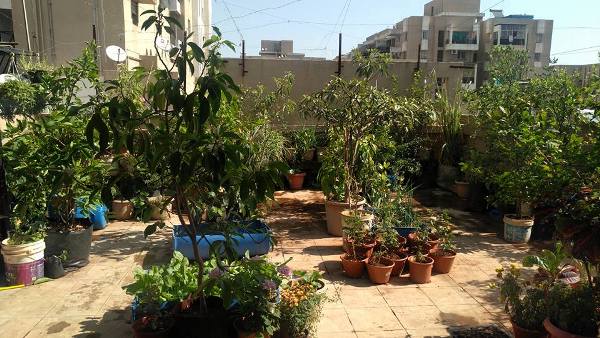
Terrace, the garden is not very expensive, you can get all the items for nurseries along with plants or seeds, containers/ growing beds/ pots, gardening equipment’s, gardening soil or potting soil and organic manures, etc. If you don’t have time or you don’t find nurseries nearby go for online shopping everything is available online.
Dedication: The key basic key for terrace gardening is your dedication. How much time do you spend taking care of plants, gardening doesn’t need hours of work, spend a minimum 1 hour a day to take care of plants. Plants need proper care.
Designing Idea for Terrace Gardening
Prepare some simple design layout for combining container gardening, vertical gardening, raised bed gardening, and hanging containers and wall-mounted containers in a compact roof to utilize space efficiently.
Prepare the Roof for Terrace Gardening:
Prepare the roof for gardening, waterproofing and draining system are main elements that you should take care of. Waterproofing can be done by yourself by covering the gardening area with a tarpaulin sheet or many professionals are available who do waterproofing of terrace. Check the strength of the terrace, if your roof can hold the weight of containers and bed, the house is built with a good amount of cement and sand it can hold a good amount of weight of the containers.
Instead of tarpaulin sheets, saucers also the best option that avoids dripping of water and soil. take in a perfect design of the garden and then set up the water-proof arrangement.
Container and Raised Beds in Terrace Gardening
Raised Beds: Raised beds are the best alternative for garden beds. Raised beds are wider than the containers they come in wide square and rectangular shapes. Raised beds give enough place for roots of plants to spread and will thus thrive with less care and maintenance.
Raised beds don’t occupy much place, they can be placed adjacent to the walls of the terrace. Raised beds are a bit expensive, but yields of plant grown in raised beds are high compared to container-grown plants. Raised beds are generally made of metals or wood, you can also construct a permanent raised bed with cement and concrete. Raised beds are available in hardware stores, nurseries, and online shops to purchase suitable ones as per your terrace space.
Always place the raised beds slightly elevated from the terrace surface to protect the roof from root penetration and water leakages. Soil in raised beds will dry out quickly so watering should be done regularly.
Integrated Patches for Terrace Gardening:
Integrated patches are also used for growing vegetables, these patches help to grow plants on the surface of the terrace itself. These integrated patches are suitable of large terraces that are completely waterproof. Integrated patches are like normal garden beds, use garden soils with organic composts to grow plants in integrated patches.
Containers for Terrace Gardening
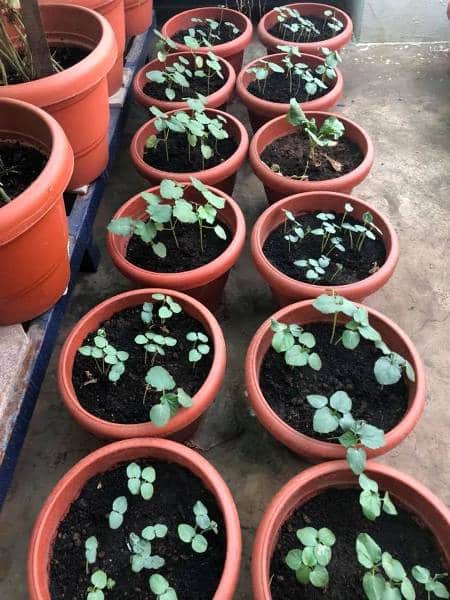
- Container is the best choice for terrace gardening. you can use containers of any size and shape for terrace gardening.
- Avoid plastic containers, plastic container will break in the long run due to the heat.
- Use containers made of wood, metal, clay, terracotta, etc.. In addition to this, you can use old paint boxes, vegetable or fruit crates, used glass or plastic bottles, sandboxes, old wheelbarrows, oil containers, etc. all types of recycled containers that can hold water and soil can be used for growing plants in terrace gardens.
- Grow bags, garbage bags, sugar bags, rice or wheat bags and cement bags are also used for growing plants.
- Select the size of the container depending on the plant size and growth.
- All the container should have 2 to 3 draining holes. Cover the draining holes with fine net that stop dripping of soil. And cover the bottom layer of containers with gravel to avoid water clogging.
- Sandboxes: Sandboxes used for kids play are the best container to use in the terrace garden. Sandboxes are used for the growing leaf vegetable patch. Sandboxes provide wide place for plants to thrive.
Vertical Growing in Terrace Gardening
- Utilize vertical space on the walls of the terrace to increase the space for gardening, and vertical gardening increases the beauty of the terrace.
- Plan for vertical gardening, if you have walls, hang planters onto.
- In vertical gardening you can grow shrubs and vine vegetables like beans, gourds, etc. Vines gets good support of walls but also save lots of space.
- For vertical gardening use some designed stands, pot holders, hangers and hanging pots etc.
- you can also hand hanging pots on the walls or use railings to grow shrub plants. And you can train our veins of the plants on the walls on strings.
- Hanging pots and stands, pot holders are available in online stores and nurseries.
Prepare a Garden Layout for Terrace Gardening
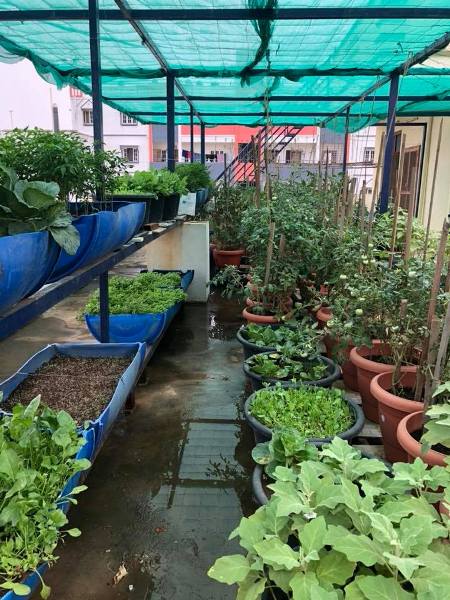
- Prepare designed layout as per our garden area considering the heat and light requirements.
- Place plants according to their resistant towards the sun. Place tender plants in shade areas, creepers in low wind areas.
- Place the containers in a convenient location so that you can water them easily.
- the Layout makes your job in placing containers.
Soil Requirement for Terrace Gardening
Soil is the key feature for growing a healthy plant. Don’t opt chemical mixed soils, it may affect the yields. Soil used should provide all nutrients for proper growth of the plants. the premium potting mix is recommended for terrace and container gardening. Mix potting soil with compost, river sand and organic manure. Using normal gardening soil is a very bad idea.
Most of the plants grow in potting mix, some plants need different types of soil like lime, and citrus plants need more acidic soil. So, change the compositions of soil as per the soil requirement.
Get the potting mixes from the nurseries, if it is costly prepare them yourself. Buy some ingredients and create own compost and prepare homemade mix.
Preparation of Home Made Potting Mix for Terrace Gardening
- Get chemical-free red soil.
- Mix it with animal manure and neem cake.
- Mix with river sand, vermicompost and coconut fiber to increase draining system.
Preparing the Soilless Potting Mix for Terrace Gardening
- Equal portions of coco peat, red sand, and vermicompost. Keep the mix potting, and store in open air before 3 weeks before planting. Add organic manure before filling into the containers.
Water Requirement for Terrace Gardening
- For terrace gardening, should have water resource near to your garden.
- Buy watering equipment like watering kettle or use a hose to water the plants in your terrace.
- You can also use buckets /mug and pour water plants in our terrace. But carrying all over terrace can be a tough job.
- Use only water cans to water plants is recommended.
- If you don’t get time water daily, implement drip irrigation.
- Many ready-made watering systems and techniques are available, you can fix them under professional advice.
- Use clean water for water, avoid chlorinated water for plants.
Seeds and Plantation for Terrace Gardening
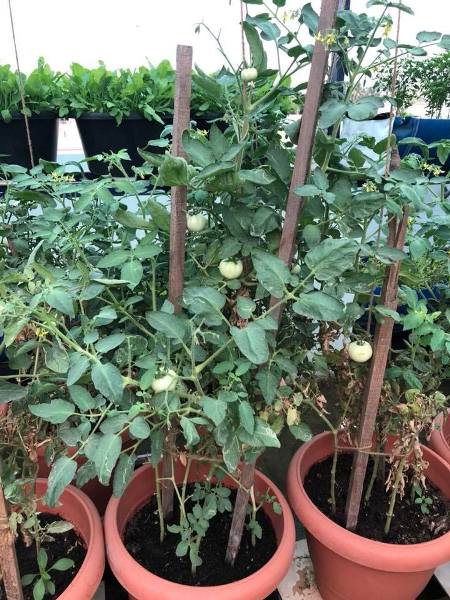
- Get the necessary seeds and seedling from nurseries, even seeds are available in online stores.
- Go for good quality organic seeds, growth of the plants depends upon the quality of seeds.
- Follow the sowing procedure according labelled instruction on seed covers.
- Some seed should be grown in seed trays and then transplanted into the desired containers.
- Get 1 set of seed trays, seeds need regular observation till the sprout.
- Select seeds that are depending upon season and climatic conditions.
- Some type plants are tough to grow from seeds, in that case get seedling from nurseries.
- Some plants are directly grown from cuttings. you can get cuttings from neighbors or friends instead of purchasing.
- Start with a minimum number of easily grown plants, you can increase the number of plants from time to time.
Fertilizers Requirement for Terrace Gardening
- Plants grown in container and beds need feed regularly, especially in the growing period.
- Don’t use chemical-based fertilizers, only organic fertilizers are recommended.
- Use mild liquid fertilizers and slow-release fertilizers.
- Natural composts like vegetable composts, fruit composts or tea composts are used as best feed.
- topdress the soil with cow manure once in six months.
- Using cow or poultry manure can give an inconvenient smell for a few days.
Pesticides Requirement for Terrace Gardening
- Once you are ready with the garden, be ready to face the pests. Whatever precaution you take, plants are affected by the pests.
- Pesticides should be used to treat pests, but go for natural ones, don’t use chemical fertilizers.
- Make a complete stud on natural pesticide and their recipes. Prepare yourself at home.
- Ginger oil, antiseptic soap spray, neem oil spray is good natural pesticide prepared at home to treat common pests.
- you can get many books in online about natural pesticides.
- Plants affected with pests or diseases should be kept separately, as chance of spreading is more in terrace gardens.
Rain Water Harvesting in Terrace Gardening
- Rainwater is a good source of nitrogen for plants.
- Make some provision in our terrace to collect the rainwater. you place large container or buckets to collect rainwater and use it later.
Garden Cover and Wind Barriers in Terrace Gardening
- In peak summer and peak winters, you need to set up some shade for plants.
- Some plants are heat resistant and some plant cannot resist midday sun; garden covers are used; lightweight UV resistant covers should be used.
- But garden covers can be expensive, in that case you shade netting of low cost.
- Just cover some area of the terrace if you are running short of budget and place plants sensitive plants under shade.
- Garden cover used in winter to protect winter sensitive plants from frost.
- Wind barriers: Major problem faced by terrace grown plants is blowing winds. Winds can spoil the vines of the plants and break the young stems. But setting up wind barriers is very expensive, if you are ready with the budget just set up barriers or fencing to protect the plants from strong winds.
Protecting Plants from Birds in Terrace Gardening
- Terrace plants should be protected from birds and animals like rats and squirrels.
- Plants bearing Vegetable, seedling, fruits should be covered with meshed or wires to protect from plants.
- Take necessary steps for preventing rats and squirrels that damage raised beds, sown seeds, young plants.
Suitable Plants for Terrace Gardening
- Terrace Garden Vegetables: With medium-sized pots or raised beds with fertile soil all other requirements you can grow all vegetables in the terrace garden like Tomatoes, Carrots, Onions, Potatoes, Beets, Capsicum, Radish, Chilies, Cucumbers, and Eggplants are easily grown. But all these vegetable plants need regular care like pinching, pruning, watering, and fertilizing should be done every week.
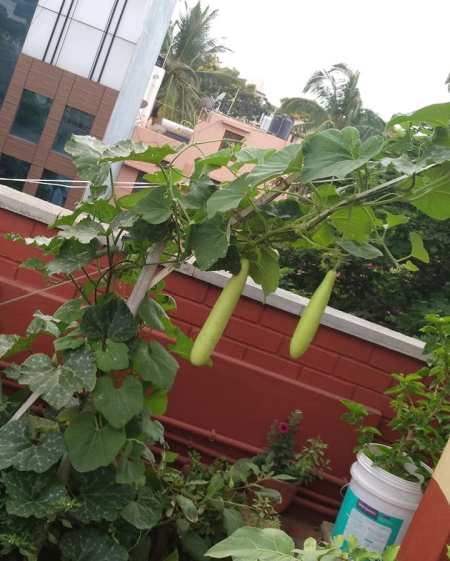
- Fruit Trees for Terrace Gardening: Select dwarf tree varieties of Orange, Guava, Lemon, Papaya, Mango, Sapodilla, Fig are best for terrace gardening.

- Flowering plants for terrace Gardening: Flowering plants like roses, Marie gold, Lilies, Jasmine, and Hibiscus can be grown. you can also grow hyacinths, tulip bulbs and colorful primroses.
Read this: Growing Tomatoes In Containers.
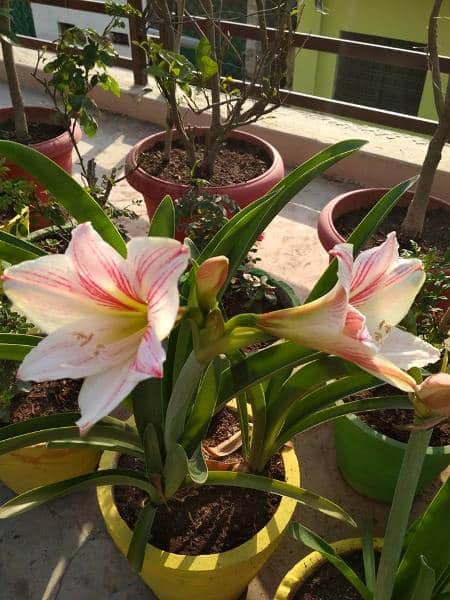
- Herbs for terrace Gardening: easily grown herbs in our terrace garden are mint, basil, curry leaf, celery, cilantro, chives, and garlic are suitable for terrace gardening.
- Plants for Vertical Gardening: Boston fern, Birds nest fern, rabbit foot fern, Pothos, lipstick plants, baby tears, etc. Vegetable for vertical garden are peas, cucumbers, pole beans, squashes, and pumpkins.
- Leaf Vegetable for terrace Gardening: Fenu Greek leaves, spinach coriander, Lettuce, Mustard leaves, Kale, Broccoli, and Lettuce, etc.
Advantages of Rooftop/Terrace Gardening
- Terrace gardening is your personal space and have you only have the access. You can harvest any produce when required.
- Terrace gardening provides cooling effect to your building due to green plants.
- Growing plants on terrace may reduce carbon monoxide and good for the environment as well.
- Terrace gardening or Rooftop gardening requires less maintenance.
- Growing plants on the terrace can get lots of Sun. If needed, a shade net can be used for shade-loving plants.
- Your building looks beautiful with terrace gardening and provides an amazing view for others.
- You can use rainwater for growing plants.
- Terrace gardening is a stress buster.
- It can also reduce daily spending cost on vegetables or fruits or herbs.
- Your relatives can also enjoy the vegetables or fruits from your terrace gardening.
Tips for Terrace Gardening
- Create a perfect theme, choose plants as per design, to create beautiful landscapes.
- Don’t be more excited to grow all the plants at the first attempt. Make a list of the plants you are planning to grow and grow one by one and arrange them on the terrace according to the heat and light requirements.
- Be prepared with failure at initial stages, due to care, overwatering, overfeeding can lead to failures. Don’t get disappointed, learn from mistakes.
- Wear gloves when working in your garden.
- Be prepared with all types of insects.
- The Internet is the best source to get complete information about plants, seeds, pests, and growing procedures.
- Choosing a right soil is very important, as soil supplies basic nutrients for plants. Mix the soil with sand and vermicompost to make it more fertile and well-drained.
- After the rainy season, add some mild organic fertilizers with essential nutrients. As the rains wash away the nutrients in the soil.
- Terrace gardening needs regular watering, in summer water the plants twice a day.
In case if you are interested in this: Hydroponic Nutrient Chart.
- Economical Aquaculture: A Guide to Low-Budget Fish Farming
- 15 Common Planting Errors That Can Doom Your Fruit Trees
- How to Make Houseplants Bushy: Effective Tips and Ideas
- Innovative Strategies for Boosting Coconut Pollination and Yield
- Pollination Strategies for Maximum Pumpkin Yield
- The Complete Guide to Chicken Fattening: Strategies for Maximum Growth
- Natural Solutions for Tulip Problems: 100% Effective Remedies for Leaf and Bulb-Related Issues
- Revolutionizing Citrus Preservation: Towards a Healthier, Greener Future
- Natural Solutions for Peony Leaf and Flower Problems: 100% Effective Remedies
- Maximizing Profits with Avocado Contract Farming in India: A Comprehensive Guide
- Natural Solutions for Hydrangea Problems: 100% Effective Remedies for Leaf and Flowers
- The Ultimate Guide to Choosing the Perfect Foliage Friend: Bringing Life Indoors
- From Sunlight to Sustainability: 15 Ways to Use Solar Technology in Agriculture
- The Ultimate Guide to Dong Tao Chicken: Exploring from History to Raising
- The Eco-Friendly Makeover: How to Convert Your Unused Swimming Pool into a Fish Pond
- Mastering the Art of Delaware Chicken Farming: Essentials for Healthy Backyard Flocks
- 20 Best Homemade Fertilizers for Money Plant: DIY Recipes and Application Methods
- How to Craft a Comprehensive Free-Range Chicken Farming Business Plan
- Brighten Your Flock: Raising Easter Egger Chickens for Beauty and Bounty
- How to Optimize Your Poultry Egg Farm Business Plan with These Strategies
- Subsidy for Spirulina Cultivation: How Indian Government Schemes Encouraging Spirulina Farmers
- Ultimate Guide to Raising Dominique Chickens: Breeding, Feeding, Egg-Production, and Care
- Mastering the Art of Raising Jersey Giant Chickens: Care, Feeding, and More
- Ultimate Guide to Raising Legbar Chickens: Breeding, Farming Practices, Diet, Egg-Production
- How to Raise Welsummer Chickens: A Comprehensive Guide for Beginners
- How to Protect Indoor Plants in Winter: A Comprehensive Guide
- Ultimate Guide to Grow Bag Gardening: Tips, Tricks, and Planting Ideas for Urban Gardeners
Fabulously useful post. I am re inspired to continue my growing of vegetables. At the moment the containers are lying empty.
Glad, you liked it. Please keep visiting for more updates on Container Gardening /Indoor Gardening/Backyard Gardening
Team, Fantastic – no words! First site to meet the common mans expectation. Very narrative in simple language still covers every other aspects. Kudos.
Thank you..we will be coming up with modern farming methods. Stay tuned!.
So nice n informative . I want to start terrace garden. I wish I can do with ur help
Very informative article! thanks for sharing.
Amazing Content. I was planning to setup a rooftop garden and this blog helped me a lot. Thanks for sharing this information.
Great post. I really appreciate the effort you put into compiling and sharing this content.
This is a great inspiring article. I am pretty much pleased with your good work. You put really very helpful information. Keep it up. Keep blogging. Looking to reading your next post.